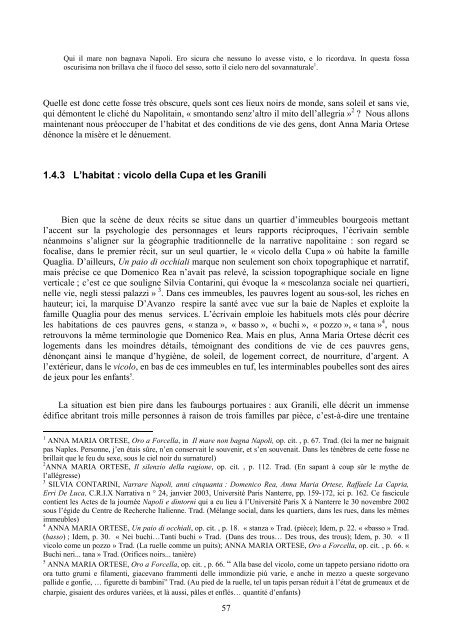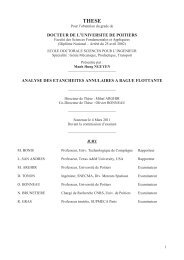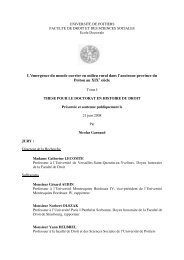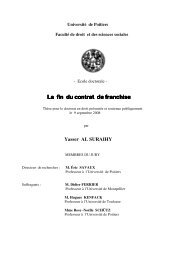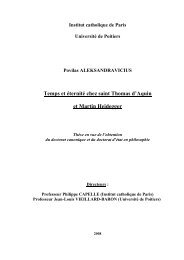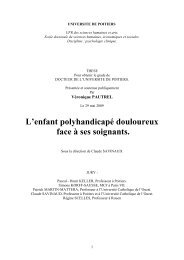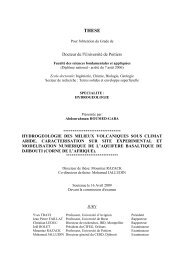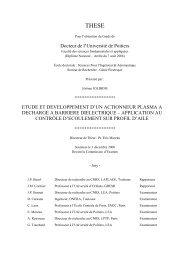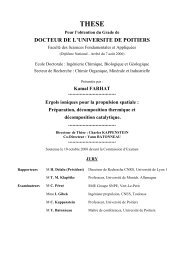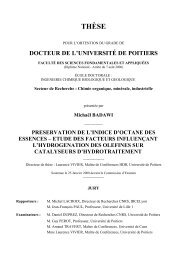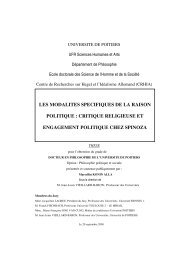Consulter le texte intégral de la thèse - Université de Poitiers
Consulter le texte intégral de la thèse - Université de Poitiers
Consulter le texte intégral de la thèse - Université de Poitiers
You also want an ePaper? Increase the reach of your titles
YUMPU automatically turns print PDFs into web optimized ePapers that Google loves.
Qui il mare non bagnava Napoli. Ero sicura che nessuno lo avesse visto, e lo ricordava. In questa fossa<br />
oscurisima non bril<strong>la</strong>va che il fuoco <strong>de</strong>l sesso, sotto il cielo nero <strong>de</strong>l sovannatura<strong>le</strong> 1 .<br />
Quel<strong>le</strong> est donc cette fosse très obscure, quels sont ces lieux noirs <strong>de</strong> mon<strong>de</strong>, sans so<strong>le</strong>il et sans vie,<br />
qui démontent <strong>le</strong> cliché du Napolitain, « smontando senz’altro il mito <strong>de</strong>ll’al<strong>le</strong>gria » 2 ? Nous allons<br />
maintenant nous préoccuper <strong>de</strong> l’habitat et <strong>de</strong>s conditions <strong>de</strong> vie <strong>de</strong>s gens, dont Anna Maria Ortese<br />
dénonce <strong>la</strong> misère et <strong>le</strong> dénuement.<br />
1.4.3 L’habitat : vicolo <strong>de</strong>l<strong>la</strong> Cupa et <strong>le</strong>s Granili<br />
Bien que <strong>la</strong> scène <strong>de</strong> <strong>de</strong>ux récits se situe dans un quartier d’immeub<strong>le</strong>s bourgeois mettant<br />
l’accent sur <strong>la</strong> psychologie <strong>de</strong>s personnages et <strong>le</strong>urs rapports réciproques, l’écrivain semb<strong>le</strong><br />
néanmoins s’aligner sur <strong>la</strong> géographie traditionnel<strong>le</strong> <strong>de</strong> <strong>la</strong> narrative napolitaine : son regard se<br />
focalise, dans <strong>le</strong> premier récit, sur un seul quartier, <strong>le</strong> « vicolo <strong>de</strong>l<strong>la</strong> Cupa » où habite <strong>la</strong> famil<strong>le</strong><br />
Quaglia. D’ail<strong>le</strong>urs, Un paio di occhiali marque non seu<strong>le</strong>ment son choix topographique et narratif,<br />
mais précise ce que Domenico Rea n’avait pas re<strong>le</strong>vé, <strong>la</strong> scission topographique socia<strong>le</strong> en ligne<br />
vertica<strong>le</strong> ; c’est ce que souligne Silvia Contarini, qui évoque <strong>la</strong> « mesco<strong>la</strong>nza socia<strong>le</strong> nei quartieri,<br />
nel<strong>le</strong> vie, negli stessi pa<strong>la</strong>zzi » 3 . Dans ces immeub<strong>le</strong>s, <strong>le</strong>s pauvres logent au sous-sol, <strong>le</strong>s riches en<br />
hauteur; ici, <strong>la</strong> marquise D’Avanzo respire <strong>la</strong> santé avec vue sur <strong>la</strong> baie <strong>de</strong> Nap<strong>le</strong>s et exploite <strong>la</strong><br />
famil<strong>le</strong> Quaglia pour <strong>de</strong>s menus services. L’écrivain emploie <strong>le</strong>s habituels mots clés pour décrire<br />
<strong>le</strong>s habitations <strong>de</strong> ces pauvres gens, « stanza », « basso », « buchi », « pozzo », « tana » 4 , nous<br />
retrouvons <strong>la</strong> même terminologie que Domenico Rea. Mais en plus, Anna Maria Ortese décrit ces<br />
logements dans <strong>le</strong>s moindres détails, témoignant <strong>de</strong>s conditions <strong>de</strong> vie <strong>de</strong> ces pauvres gens,<br />
dénonçant ainsi <strong>le</strong> manque d’hygiène, <strong>de</strong> so<strong>le</strong>il, <strong>de</strong> logement correct, <strong>de</strong> nourriture, d’argent. A<br />
l’extérieur, dans <strong>le</strong> vicolo, en bas <strong>de</strong> ces immeub<strong>le</strong>s en tuf, <strong>le</strong>s interminab<strong>le</strong>s poubel<strong>le</strong>s sont <strong>de</strong>s aires<br />
<strong>de</strong> jeux pour <strong>le</strong>s enfants 5 .<br />
La situation est bien pire dans <strong>le</strong>s faubourgs portuaires : aux Granili, el<strong>le</strong> décrit un immense<br />
édifice abritant trois mil<strong>le</strong> personnes à raison <strong>de</strong> trois famil<strong>le</strong>s par pièce, c’est-à-dire une trentaine<br />
1<br />
ANNA MARIA ORTESE, Oro a Forcel<strong>la</strong>, in Il mare non bagna Napoli, op. cit. , p. 67. Trad. (Ici <strong>la</strong> mer ne baignait<br />
pas Nap<strong>le</strong>s. Personne, j’en étais sûre, n’en conservait <strong>le</strong> souvenir, et s’en souvenait. Dans <strong>le</strong>s ténèbres <strong>de</strong> cette fosse ne<br />
bril<strong>la</strong>it que <strong>le</strong> feu du sexe, sous <strong>le</strong> ciel noir du surnaturel)<br />
2<br />
ANNA MARIA ORTESE, Il si<strong>le</strong>nzio <strong>de</strong>l<strong>la</strong> ragione, op. cit. , p. 112. Trad. (En sapant à coup sûr <strong>le</strong> mythe <strong>de</strong><br />
l’allégresse)<br />
3<br />
SILVIA CONTARINI, Narrare Napoli, anni cinquanta : Domenico Rea, Anna Maria Ortese, Raffae<strong>le</strong> La Capria,<br />
Erri De Luca, C.R.I.X Narrativa n ° 24, janvier 2003, <strong>Université</strong> Paris Nanterre, pp. 159-172, ici p. 162. Ce fascicu<strong>le</strong><br />
contient <strong>le</strong>s Actes <strong>de</strong> <strong>la</strong> journée Napoli e dintorni qui a eu lieu à l’<strong>Université</strong> Paris X à Nanterre <strong>le</strong> 30 novembre 2002<br />
sous l’égi<strong>de</strong> du Centre <strong>de</strong> Recherche Italienne. Trad. (Mé<strong>la</strong>nge social, dans <strong>le</strong>s quartiers, dans <strong>le</strong>s rues, dans <strong>le</strong>s mêmes<br />
immeub<strong>le</strong>s)<br />
4<br />
ANNA MARIA ORTESE, Un paio di occhiali, op. cit. , p. 18. « stanza » Trad. (pièce); I<strong>de</strong>m, p. 22. « «basso » Trad.<br />
(basso) ; I<strong>de</strong>m, p. 30. « Nei buchi…Tanti buchi » Trad. (Dans <strong>de</strong>s trous… Des trous, <strong>de</strong>s trous); I<strong>de</strong>m, p. 30. « Il<br />
vicolo come un pozzo » Trad. (La ruel<strong>le</strong> comme un puits); ANNA MARIA ORTESE, Oro a Forcel<strong>la</strong>, op. cit. , p. 66. «<br />
Buchi neri... tana » Trad. (Orifices noirs... tanière)<br />
5<br />
ANNA MARIA ORTESE, Oro a Forcel<strong>la</strong>, op. cit. , p. 66. “ Al<strong>la</strong> base <strong>de</strong>l vicolo, come un tappeto persiano ridotto ora<br />
ora tutto grumi e fi<strong>la</strong>menti, giacevano frammenti <strong>de</strong>l<strong>le</strong> immondizie più varie, e anche in mezzo a queste sorgevano<br />
palli<strong>de</strong> e gonfie, … figurette di bambini” Trad. (Au pied <strong>de</strong> <strong>la</strong> ruel<strong>le</strong>, tel un tapis persan réduit à l’état <strong>de</strong> grumeaux et <strong>de</strong><br />
charpie, gisaient <strong>de</strong>s ordures variées, et là aussi, pâ<strong>le</strong>s et enflés… quantité d’enfants)<br />
57


